University Law Module LAW 3: Statutory Interpretation Case Summary
VerifiedAdded on 2022/09/09
|5
|990
|23
Case Study
AI Summary
This case study examines statutory interpretation, a critical process courts use to apply and execute laws, particularly when dealing with statutes. It explores different rules of interpretation, including the literal, golden, and mischief rules. The analysis focuses on two landmark cases: Mandla vs. Dowell Lee, which addresses the definition of an ethnic group in the context of the Race Relations Act of 1976, and R (Begum) vs. Governors of Denbigh High School, which concerns religious symbols and clothing under the Human Rights Act of 1998. The case study details the facts, legal arguments, and court decisions in each case, highlighting how judges apply the rules of statutory interpretation to reach their conclusions. The document also references relevant legal literature to provide a comprehensive understanding of the subject.
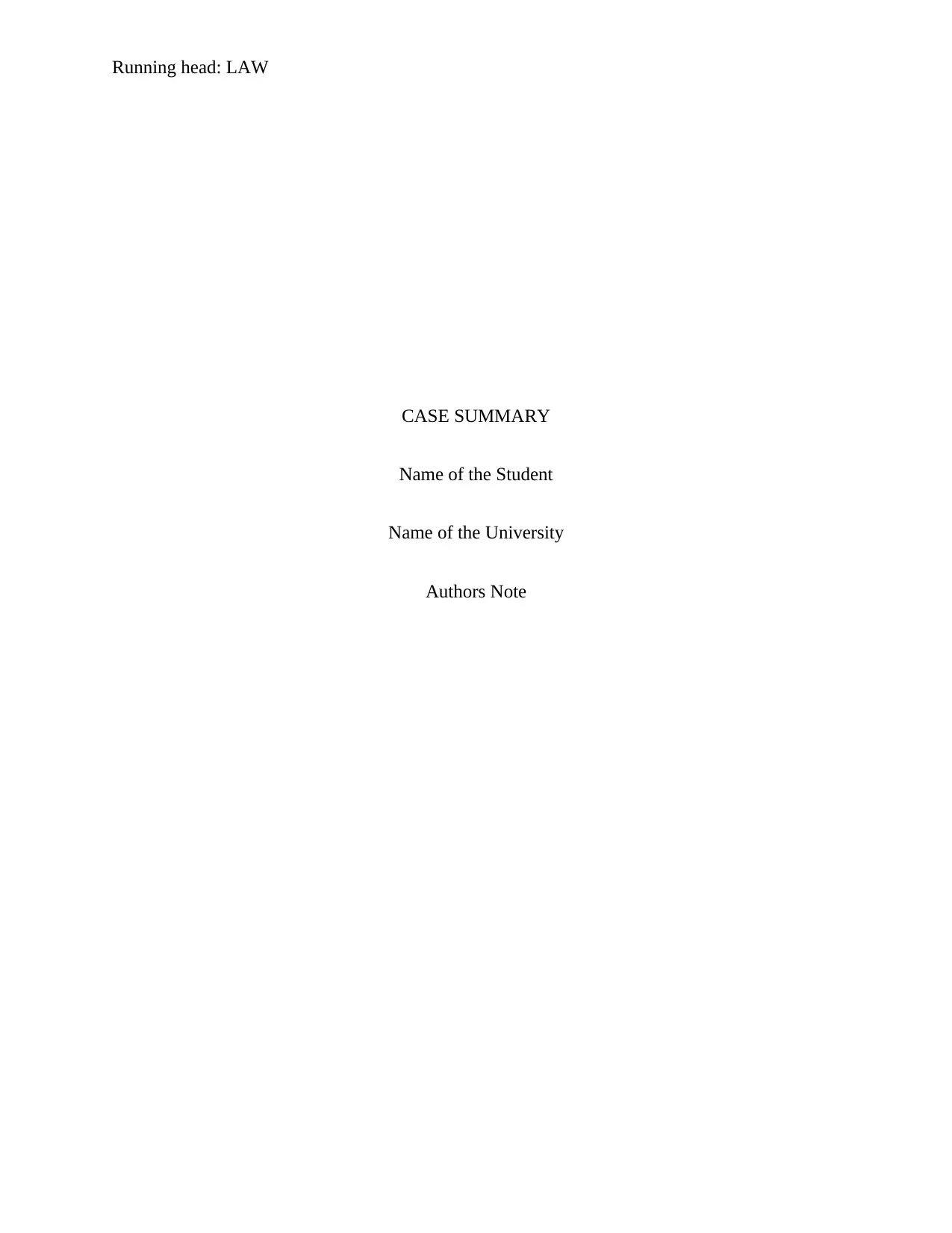
Running head: LAW
CASE SUMMARY
Name of the Student
Name of the University
Authors Note
CASE SUMMARY
Name of the Student
Name of the University
Authors Note
Paraphrase This Document
Need a fresh take? Get an instant paraphrase of this document with our AI Paraphraser
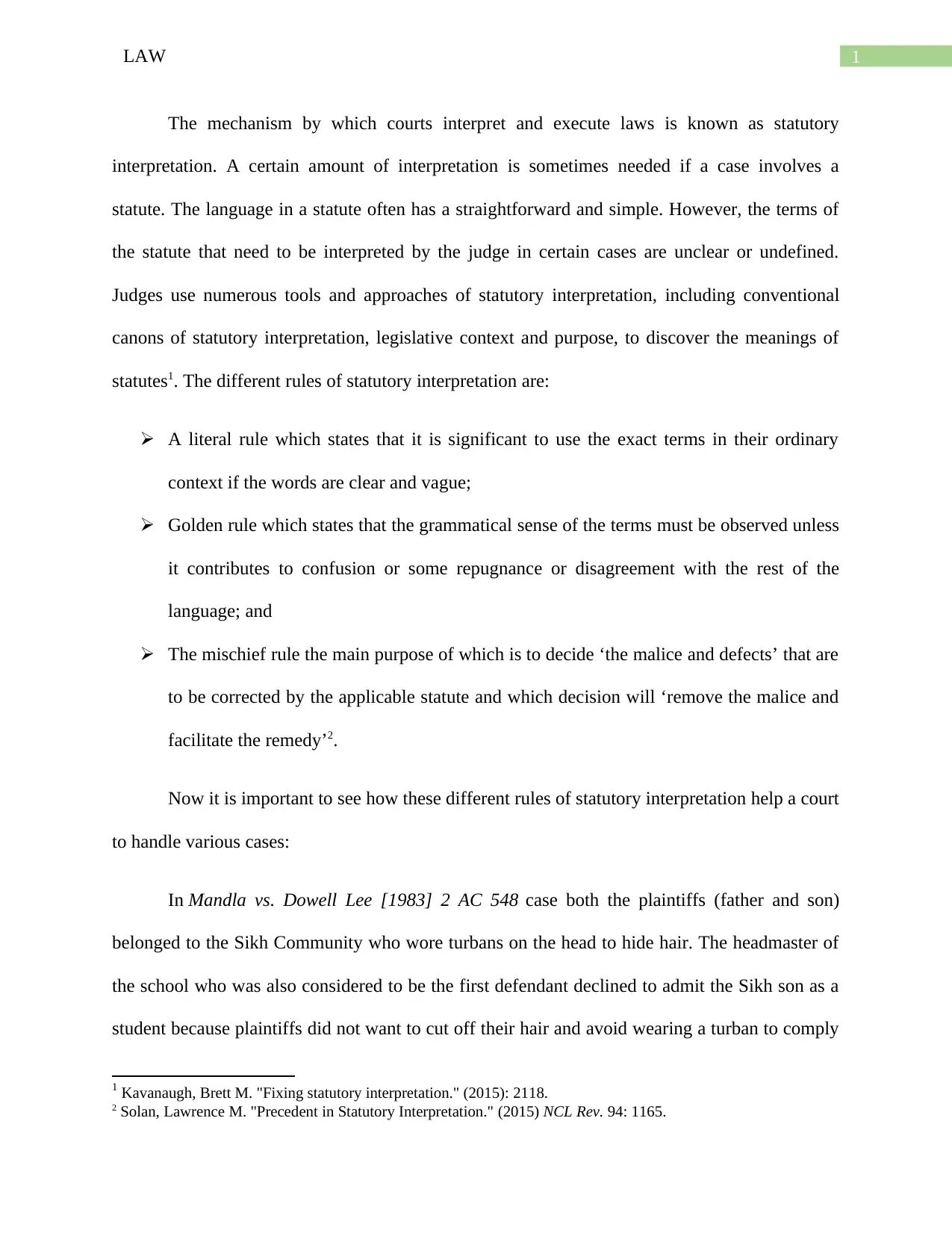
1LAW
The mechanism by which courts interpret and execute laws is known as statutory
interpretation. A certain amount of interpretation is sometimes needed if a case involves a
statute. The language in a statute often has a straightforward and simple. However, the terms of
the statute that need to be interpreted by the judge in certain cases are unclear or undefined.
Judges use numerous tools and approaches of statutory interpretation, including conventional
canons of statutory interpretation, legislative context and purpose, to discover the meanings of
statutes1. The different rules of statutory interpretation are:
A literal rule which states that it is significant to use the exact terms in their ordinary
context if the words are clear and vague;
Golden rule which states that the grammatical sense of the terms must be observed unless
it contributes to confusion or some repugnance or disagreement with the rest of the
language; and
The mischief rule the main purpose of which is to decide ‘the malice and defects’ that are
to be corrected by the applicable statute and which decision will ‘remove the malice and
facilitate the remedy’2.
Now it is important to see how these different rules of statutory interpretation help a court
to handle various cases:
In Mandla vs. Dowell Lee [1983] 2 AC 548 case both the plaintiffs (father and son)
belonged to the Sikh Community who wore turbans on the head to hide hair. The headmaster of
the school who was also considered to be the first defendant declined to admit the Sikh son as a
student because plaintiffs did not want to cut off their hair and avoid wearing a turban to comply
1 Kavanaugh, Brett M. "Fixing statutory interpretation." (2015): 2118.
2 Solan, Lawrence M. "Precedent in Statutory Interpretation." (2015) NCL Rev. 94: 1165.
The mechanism by which courts interpret and execute laws is known as statutory
interpretation. A certain amount of interpretation is sometimes needed if a case involves a
statute. The language in a statute often has a straightforward and simple. However, the terms of
the statute that need to be interpreted by the judge in certain cases are unclear or undefined.
Judges use numerous tools and approaches of statutory interpretation, including conventional
canons of statutory interpretation, legislative context and purpose, to discover the meanings of
statutes1. The different rules of statutory interpretation are:
A literal rule which states that it is significant to use the exact terms in their ordinary
context if the words are clear and vague;
Golden rule which states that the grammatical sense of the terms must be observed unless
it contributes to confusion or some repugnance or disagreement with the rest of the
language; and
The mischief rule the main purpose of which is to decide ‘the malice and defects’ that are
to be corrected by the applicable statute and which decision will ‘remove the malice and
facilitate the remedy’2.
Now it is important to see how these different rules of statutory interpretation help a court
to handle various cases:
In Mandla vs. Dowell Lee [1983] 2 AC 548 case both the plaintiffs (father and son)
belonged to the Sikh Community who wore turbans on the head to hide hair. The headmaster of
the school who was also considered to be the first defendant declined to admit the Sikh son as a
student because plaintiffs did not want to cut off their hair and avoid wearing a turban to comply
1 Kavanaugh, Brett M. "Fixing statutory interpretation." (2015): 2118.
2 Solan, Lawrence M. "Precedent in Statutory Interpretation." (2015) NCL Rev. 94: 1165.
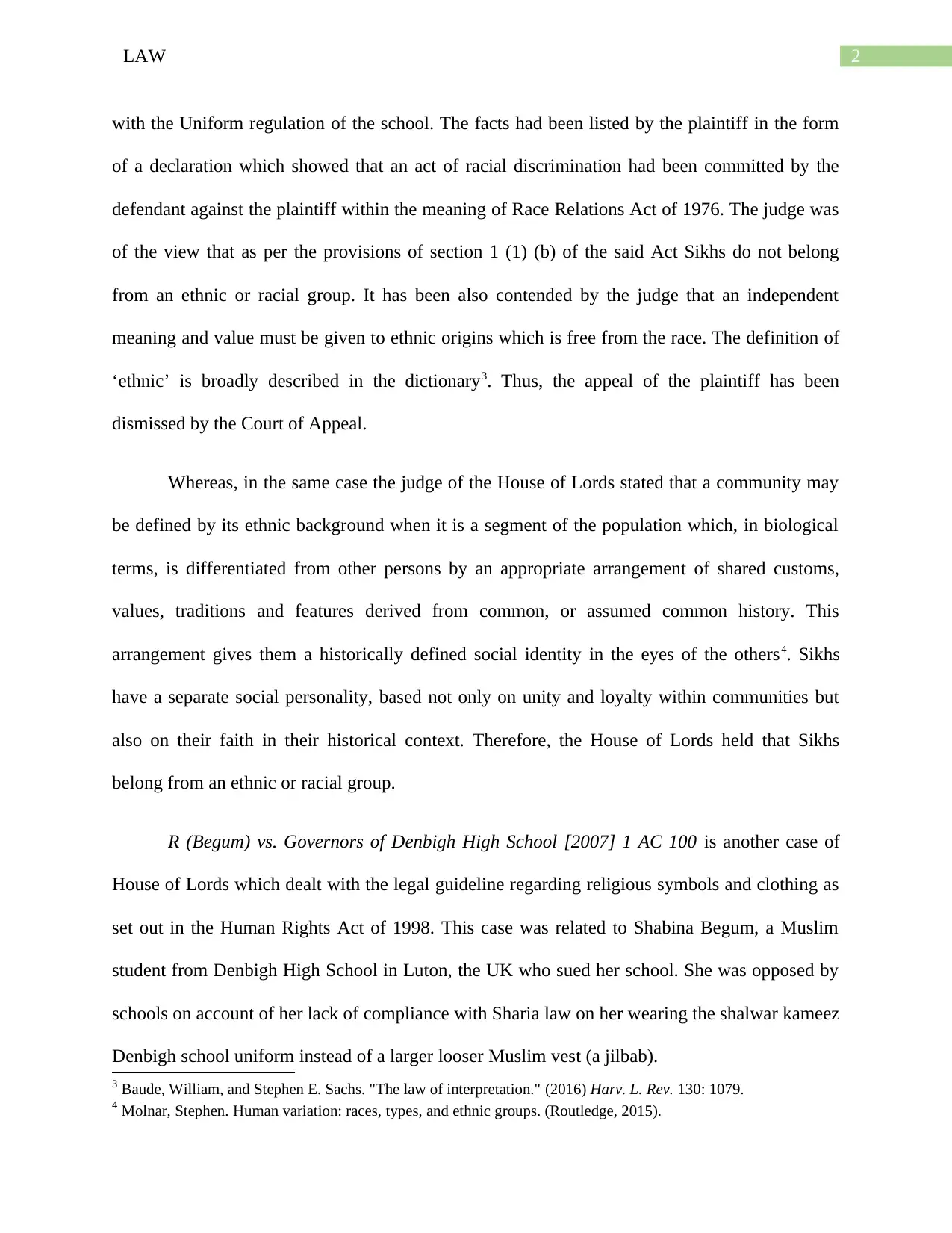
2LAW
with the Uniform regulation of the school. The facts had been listed by the plaintiff in the form
of a declaration which showed that an act of racial discrimination had been committed by the
defendant against the plaintiff within the meaning of Race Relations Act of 1976. The judge was
of the view that as per the provisions of section 1 (1) (b) of the said Act Sikhs do not belong
from an ethnic or racial group. It has been also contended by the judge that an independent
meaning and value must be given to ethnic origins which is free from the race. The definition of
‘ethnic’ is broadly described in the dictionary3. Thus, the appeal of the plaintiff has been
dismissed by the Court of Appeal.
Whereas, in the same case the judge of the House of Lords stated that a community may
be defined by its ethnic background when it is a segment of the population which, in biological
terms, is differentiated from other persons by an appropriate arrangement of shared customs,
values, traditions and features derived from common, or assumed common history. This
arrangement gives them a historically defined social identity in the eyes of the others4. Sikhs
have a separate social personality, based not only on unity and loyalty within communities but
also on their faith in their historical context. Therefore, the House of Lords held that Sikhs
belong from an ethnic or racial group.
R (Begum) vs. Governors of Denbigh High School [2007] 1 AC 100 is another case of
House of Lords which dealt with the legal guideline regarding religious symbols and clothing as
set out in the Human Rights Act of 1998. This case was related to Shabina Begum, a Muslim
student from Denbigh High School in Luton, the UK who sued her school. She was opposed by
schools on account of her lack of compliance with Sharia law on her wearing the shalwar kameez
Denbigh school uniform instead of a larger looser Muslim vest (a jilbab).
3 Baude, William, and Stephen E. Sachs. "The law of interpretation." (2016) Harv. L. Rev. 130: 1079.
4 Molnar, Stephen. Human variation: races, types, and ethnic groups. (Routledge, 2015).
with the Uniform regulation of the school. The facts had been listed by the plaintiff in the form
of a declaration which showed that an act of racial discrimination had been committed by the
defendant against the plaintiff within the meaning of Race Relations Act of 1976. The judge was
of the view that as per the provisions of section 1 (1) (b) of the said Act Sikhs do not belong
from an ethnic or racial group. It has been also contended by the judge that an independent
meaning and value must be given to ethnic origins which is free from the race. The definition of
‘ethnic’ is broadly described in the dictionary3. Thus, the appeal of the plaintiff has been
dismissed by the Court of Appeal.
Whereas, in the same case the judge of the House of Lords stated that a community may
be defined by its ethnic background when it is a segment of the population which, in biological
terms, is differentiated from other persons by an appropriate arrangement of shared customs,
values, traditions and features derived from common, or assumed common history. This
arrangement gives them a historically defined social identity in the eyes of the others4. Sikhs
have a separate social personality, based not only on unity and loyalty within communities but
also on their faith in their historical context. Therefore, the House of Lords held that Sikhs
belong from an ethnic or racial group.
R (Begum) vs. Governors of Denbigh High School [2007] 1 AC 100 is another case of
House of Lords which dealt with the legal guideline regarding religious symbols and clothing as
set out in the Human Rights Act of 1998. This case was related to Shabina Begum, a Muslim
student from Denbigh High School in Luton, the UK who sued her school. She was opposed by
schools on account of her lack of compliance with Sharia law on her wearing the shalwar kameez
Denbigh school uniform instead of a larger looser Muslim vest (a jilbab).
3 Baude, William, and Stephen E. Sachs. "The law of interpretation." (2016) Harv. L. Rev. 130: 1079.
4 Molnar, Stephen. Human variation: races, types, and ethnic groups. (Routledge, 2015).
⊘ This is a preview!⊘
Do you want full access?
Subscribe today to unlock all pages.

Trusted by 1+ million students worldwide
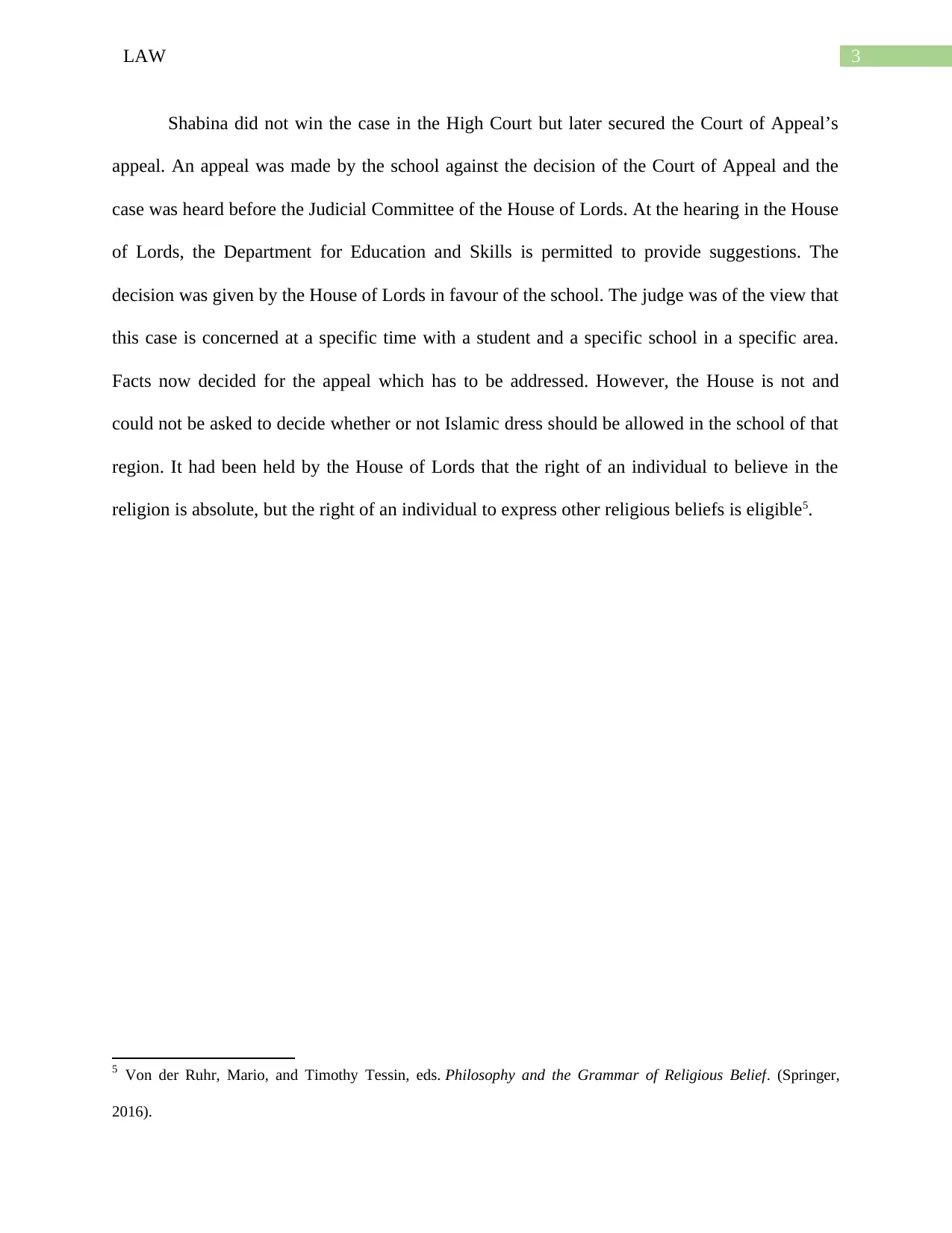
3LAW
Shabina did not win the case in the High Court but later secured the Court of Appeal’s
appeal. An appeal was made by the school against the decision of the Court of Appeal and the
case was heard before the Judicial Committee of the House of Lords. At the hearing in the House
of Lords, the Department for Education and Skills is permitted to provide suggestions. The
decision was given by the House of Lords in favour of the school. The judge was of the view that
this case is concerned at a specific time with a student and a specific school in a specific area.
Facts now decided for the appeal which has to be addressed. However, the House is not and
could not be asked to decide whether or not Islamic dress should be allowed in the school of that
region. It had been held by the House of Lords that the right of an individual to believe in the
religion is absolute, but the right of an individual to express other religious beliefs is eligible5.
5 Von der Ruhr, Mario, and Timothy Tessin, eds. Philosophy and the Grammar of Religious Belief. (Springer,
2016).
Shabina did not win the case in the High Court but later secured the Court of Appeal’s
appeal. An appeal was made by the school against the decision of the Court of Appeal and the
case was heard before the Judicial Committee of the House of Lords. At the hearing in the House
of Lords, the Department for Education and Skills is permitted to provide suggestions. The
decision was given by the House of Lords in favour of the school. The judge was of the view that
this case is concerned at a specific time with a student and a specific school in a specific area.
Facts now decided for the appeal which has to be addressed. However, the House is not and
could not be asked to decide whether or not Islamic dress should be allowed in the school of that
region. It had been held by the House of Lords that the right of an individual to believe in the
religion is absolute, but the right of an individual to express other religious beliefs is eligible5.
5 Von der Ruhr, Mario, and Timothy Tessin, eds. Philosophy and the Grammar of Religious Belief. (Springer,
2016).
Paraphrase This Document
Need a fresh take? Get an instant paraphrase of this document with our AI Paraphraser
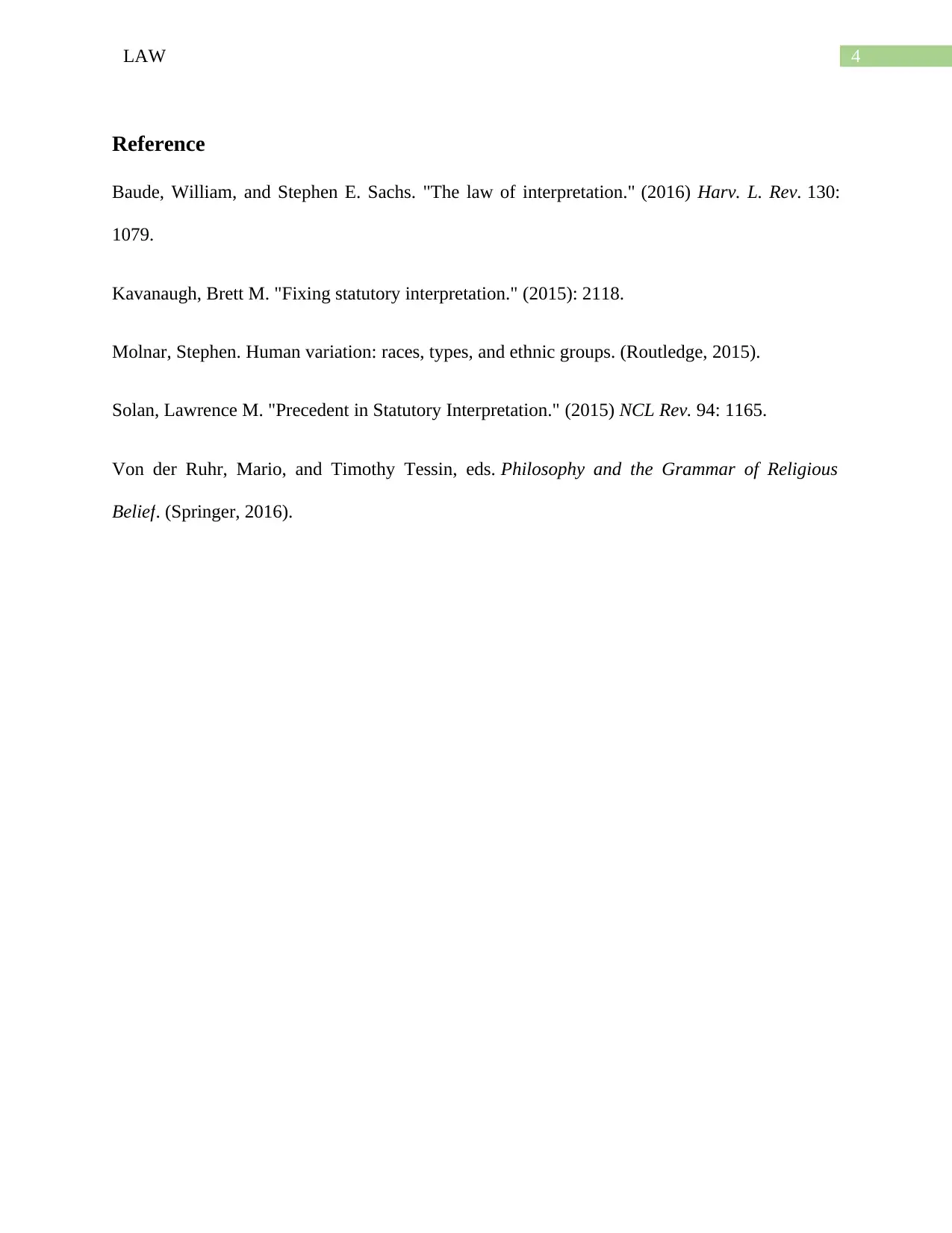
4LAW
Reference
Baude, William, and Stephen E. Sachs. "The law of interpretation." (2016) Harv. L. Rev. 130:
1079.
Kavanaugh, Brett M. "Fixing statutory interpretation." (2015): 2118.
Molnar, Stephen. Human variation: races, types, and ethnic groups. (Routledge, 2015).
Solan, Lawrence M. "Precedent in Statutory Interpretation." (2015) NCL Rev. 94: 1165.
Von der Ruhr, Mario, and Timothy Tessin, eds. Philosophy and the Grammar of Religious
Belief. (Springer, 2016).
Reference
Baude, William, and Stephen E. Sachs. "The law of interpretation." (2016) Harv. L. Rev. 130:
1079.
Kavanaugh, Brett M. "Fixing statutory interpretation." (2015): 2118.
Molnar, Stephen. Human variation: races, types, and ethnic groups. (Routledge, 2015).
Solan, Lawrence M. "Precedent in Statutory Interpretation." (2015) NCL Rev. 94: 1165.
Von der Ruhr, Mario, and Timothy Tessin, eds. Philosophy and the Grammar of Religious
Belief. (Springer, 2016).
1 out of 5
Related Documents
Your All-in-One AI-Powered Toolkit for Academic Success.
+13062052269
info@desklib.com
Available 24*7 on WhatsApp / Email
![[object Object]](/_next/static/media/star-bottom.7253800d.svg)
Unlock your academic potential
Copyright © 2020–2025 A2Z Services. All Rights Reserved. Developed and managed by ZUCOL.





